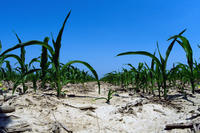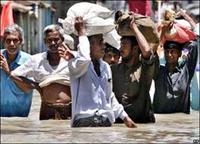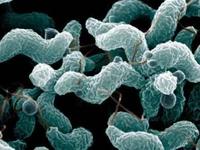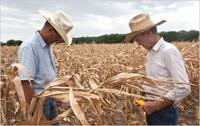-
The historical probability of drought

Droughts can severely limit crop growth, causing yearly losses of around $8 billion in the United States. It may be possible, however, to minimize those losses if farmers can synchronize the growth of crops with periods of time when drought is less likely to occur. Researchers are working to create a reliable “calendar” of seasonal drought patterns that could help farmers optimize crop production by avoiding days prone to drought.
-
-
Better predictions of Asian summer monsoons, tropical storms

The amount of rainfall and number of tropical storms during the summer monsoon season greatly impact the agriculture, economy, and people in Asia. Though meteorologists and climate scientists have worked for years to develop helpful prediction systems, seasonal predictions of these two types of weather phenomena are still poor. Scientists have now made a promising breakthrough for predicting in spring both the summer monsoon rainfall over East Asia and the number of tropical storms affecting East Asian coastal areas.
-
-
South African study highlights African fuelwood crisis
Researchers have found that at current consumption levels in the communal areas of Lowveld, South Africa, reserves of fuelwood could be totally exhausted within thirteen years. The consequences are significant, with around half of the 2.4 million rural households in the country using wood as their primary fuel source, burning between four and seven million tons per year.
-
-
Better screening for bacteria for safer food

There are around 5.4 million cases of food-borne gastroenteritis in Australia every year. Of these cases, it is estimated that around 200,000 are associated with the bacteria Campylobacter jejuni and Campylobacter coli. Chicken meat and other foods will be able to be screened for bacteria even faster and more effectively than ever, thanks to breakthrough nanobiotechnology research.
-
-
Global warming threatens U.K. diet
The number of days with temperatures over 32 degrees C has more than doubled in some parts of France over the last fifty years. Many other land areas show similar increases. By the 2020s, temperatures over 32 degrees C could occur over large areas of France where previously they were uncommon. Maize yields are reduced significantly for each day with temperatures over around 32 degrees Celsius. The United Kingdom imports more maize from France than anywhere else in the world, and declining crop yields in France mean that U.K. consumers will have to pay more for maize-based foods, or change their diets.
-
-
Drought, heat turn hundreds of U.S. counties into disaster areas

The U.S. Agriculture Department (USDA) last week said that drought conditions and heat necessitated designating 597 counties in fourteen states as primary natural disaster areas. The affected counties have suffered severe drought for eight consecutive weeks, which qualified them for the automatic designation. 2012 had been the hottest year on record for the continental United States: the year’s average temperature of 55.3 degrees Fahrenheit across the Lower 48, which was more than 3.2 degrees warmer than the average for the twentieth century.
-
-
Fish zapping: shocking Asian carp out of Midwest waters not feasible
The several species known as Asian carp are not native to U.S. waterways but have been found in rivers throughout the Midwest; these fish are competing with native species for food and altering ecosystems; they are also dangerous to boaters and other river users since Asian carp can weigh up to sixty pounds and are known to jump out of the water during even minor disturbances; scientists had hoped to modify or expand low-voltage electrical barriers like those used around Chicago waterways to direct Asian carp from particular areas, but found that the level of electricity needed would be far too high
-
-
FDA issues new food safety rules to fight contamination
One in six Americans becomes ill from eating contaminated food each year; most of them recover without harm, but bout 130,000 are hospitalized and 3,000 die; the FDA estimates the new food safety rules could prevent about 1.75 million illnesses each year
-
-
Texas drought helps in demonstrating viability of drought-tolerant corn
There is nothing like a couple years of drought to help determine the advances being made in drought-tolerant corn, and the historic drought in Texas in 2011 and in the Corn Belt in 2012 helped Texas A&M scientists show that different types of drought-tolerant corn performed well with far lower levels of irrigation
-
-
New food-safety tests may not be very good at detecting food poisoning outbreak
CDC reports that one in six Americans get sick from food- borne illnesses every year, and 3,000 people a year die from food poisoning; new detection method for food-borne illnesses will be faster to detect an illness, but these new tests cannot detect specific differences between different subtypes of bacteria, as current tests can; the ability to detect these differences is what states and the federal government use to match a sick person to a contaminated food source
-
-
Haiti's food situation looks bleak in Sandy’s aftermath
The aftermath of Hurricane Sandy, which ripped through southern Haiti in October, will extend beyond destruction and injury; the current and future food security looks bleak barring significant intervention during the next year
-
-
U.S. intelligence forecast: growing interstate conflicts over food, water

The U.S. National Intelligence Council, the research arm of the Office of the Director of National Intelligence, yesterday released its Global Trends 2030; the report’s authors say that food, water, and energy will be more scarce; “Nearly half of the world’s population will live in areas experiencing severe water stress,” the report notes; Africa and the Middle East will be most at risk of food and water shortages, with China and India also vulnerable; one bright spot for the United States: energy independence sometime between 2020 and 2030
-
-
Water resources management in a changing world
Visualize a dusty place where stream beds are sand and lakes are flats of dried mud; are we on Mars? In fact, we are on arid parts of Earth, a planet where water covers some 70 percent of the surface; how long will water be readily available to nourish life here? In the United States, more than thirty-six states face water shortages; other parts of the world are faring no better
-
-
World’s great rivers running on empty
Four of the world’s great rivers are all suffering from drastically reduced flows as a direct result of water extraction, according to new research; the researchers found that in all four river basins, over a long period of time, outflows have greatly reduced as a direct result of increased water extractions, and that urgent changes in governance of water are needed to ensure the systems remain healthy and viable
-
-
The challenge of securing food and water supplies in the twenty-first century
Participants in the Food Security in Dry Lands (FSDL) conference, held last week in Qatar, agreed that the task of managing food and water resources more efficiently and improving the security of supply are set to become one of the biggest challenges for policy makers in the twenty-first century
-
- All
- Regional
- Water
- Biometrics
- Borders/Immig
- Business
- Cybersecurity
- Detection
- Disasters
- Government
- Infrastructure
- International
- Public health
- Public Safety
- Communication interoperabillity
- Emergency services
- Emergency medical services
- Fire
- First response
- IEDs
- Law Enforcement
- Law Enforcement Technology
- Military technology
- Nonlethal weapons
- Nuclear weapons
- Personal protection equipment
- Police
- Notification /alert systems
- Situational awareness
- Weapons systems
- Sci-Tech
- Sector Reports
- Surveillance
- Transportation
Advertising & Marketing: advertise@newswirepubs.com
Editorial: editor@newswirepubs.com
General: info@newswirepubs.com
2010-2011 © News Wire Publications, LLC News Wire Publications, LLC
220 Old Country Road | Suite 200 | Mineola | New York | 11501
Permissions and Policies
Editorial: editor@newswirepubs.com
General: info@newswirepubs.com
2010-2011 © News Wire Publications, LLC News Wire Publications, LLC
220 Old Country Road | Suite 200 | Mineola | New York | 11501
Permissions and Policies
